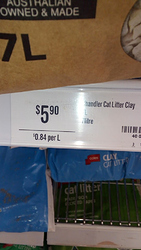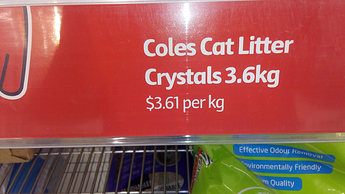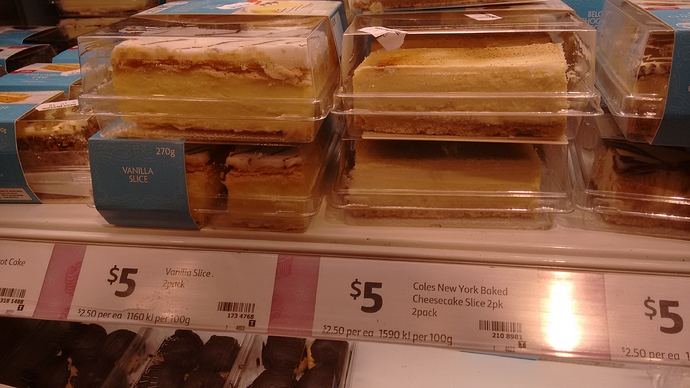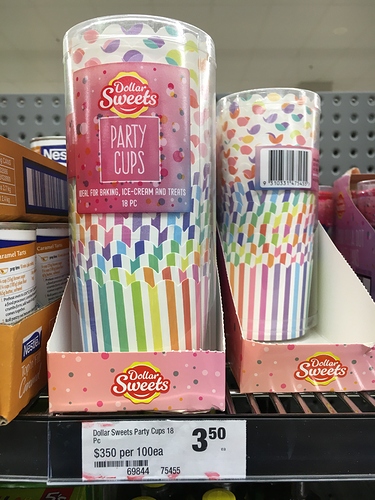Thanks for posting this online unit pricing with fruit items priced per each per kg. The per each price is given to help people order an precise number of items but they are charged on a per kg basis. Coles’ does the same, however I think but its website is better 'cos it says clearly that the price per piece of fruit is an estimate.
The whole unit pricing issue has been blown out of proportion. We all did basic arithmetic in primary school. We all have a calculator on our mobile phone, if required. All this advocacy assumes most people are dummies, which is not healthy for our society at all. All through evolution, the survivors have used their brains. That is a vital life skill.
Serious question: Do you know why most POS terminals give the staff the price, the staff enters the payment amount, and then displays how much change to give? There is a serious deficiency in numeracy that is only getting worse. Mobile phone calculators are not a solution for multiple reasons from convenience to battery life to screens going dark after 15-30 seconds…not mentioning the lack of numeracy skills… one needs to know what to divide by what, for a start!
I would have to disagree.
Unless one shops at say Aldi, where there is no choice in products available and where unit price comparison value is very limited, unit price saves a lot of time and effort. This saving in time is even for those of us who are not dummies.
I do enjoy exercising my brain (e.g. estimating bill prices at restaurants based on the meals bought at the table), but I have better things to do than work out unit prices for multiple sized items, multiple brands all at different prices. Take a product like baked beans (first thing that came into my head). There are numerous product lines available such as these and looking at the Woolworths website there are scores of different products one may decide to purchase when browsing the shelves.
If the unit prices were not displayed, then it would take one possible 10 minutes to calculate and record the unit prices for each product. Recording would be required as the average human brain is unable to handle more than 7 (to maybe 10 for those who have exercised brains) numbers at one time.
Say you had to buy 20 products for that shop, one could spend the good part of a day doing some simple arithmetic to determine if the products in ones basket/trolley have the lowest unit prices, assuming that the lowest unit price is one of the major factors in making a purchase decision.
While it may be enjoyable for some to do this, this is time I would never get back. I would rather have unit pricing calculated for me and use the saved time with family or doing things that I enjoy.
Exactly. The sodium content (especially for baked beans) may be all you need to read on the label. A few cents each way is far less important in many cases.
While these are not errors they are different unit pricing on very similar products some per kg some per litre. How do you compare across that?
There’s a reason before unit pricing became common products started to shift packaging sizes and shrinkage started to occur en mass. Those 750g blocks of cheese or thinner/lighter cereal boxes or 15g lighter chip packets … funnily enough seemingly priced close to their larger cousins giving an appearance of better value or the same value as the product was before it shrunk (price increase via stealth).
I shop at a Foodland, and I predominantly shop by unit pricing (much easier to tell when a ‘sale’ is a sale too once you get accustomed to ones staples and the unit cost). Not necessarily the lowest price always but like you suggest I simply don’t have the time to manually do what some automated system can do in a heartbeat and same me a whole heap of time.
It makes it far easier to put an accurate cost/value to those other factors however (or even if buying in larger quantity is much of a saving … plenty of times specials have meant the smaller package ends up cheaper).
Even if the the unit price of all items is shown accurately one could never chose between them as the human brain would have forgotten the first before getting to the last. Even with a notepad you would be for ever battling to stop the eighth, ninth and tenth items you have read slipping away from your mind before choosing the cheapest.
Perhaps in your world, but not in mine. We use unit pricing every time we shop and do not need a notepad, nor do we forget while comparing. You make a simple concept complex for the sake of your ‘con’ argument as I see it.
My view is there is high value in unit pricing comparing different sizes of the same product as well as comparable products.
It was not me your honour who introduced the farce but I do confess to tickling its tummy just a bit once it was in the room.
What is the correct emoticon for parody through exaggeration? ![]()
I agree that unit pricing is of greatest benefit to consumers when there is a great choice of products/items.
However, we need to remember that unit pricing is not just provided for products in constant measure packages - which is what the 2009 mandatory code covers. It is also provided (under Trade Measurement law) for products sold loose from bulk and in random measure (catch weight) packs. This greatly increases the opportunities and need to compare unit prices and not just use rules of thumb such as unpackaged will always be better value than packaged.
I wrote about this, and potential savings, in this recent Money magazine article:
http://moneymag.com.au/slash-grocery-bill-unit-pricing/
I shop mostly at Aldi and find unit pricing very helpful there for many types of comparisons. Examples include: honey in different pack types and sizes, different packs and types of toilet paper, different size trays of chilled meat, and packaged and unpackaged fruit and vegetables,
A Coles fail. The photo is from 30 Sep and some similar items on the shelf had unit pricing per 100g, but the 2 serve slices and cheese cakes were priced by the piece even though they show kj per 100g. FWIW each packet is labeled as 220g.
It makes no sense why some products including the full sized cakes were unit priced per 100g, but the same products in the ‘meal sized’ package are ‘unit priced’ by the piece even while similar dessert products were unit priced by 100g.
Woolies gets a gong. 5kg at $11.50 is an incredible deal at $2.30kg, or the pack should be $57.50, or the pack is really 1kg. Could it be none of it is correct and all of the weight, price, and unit prices are wrong? 

Might fill the fridge/freezer and onsell it at that price. Looks like it should have been per kilo…
The unit pricing is displayed as $350/100.
There are 18 cups in the packet, so the unit price is actually $19.45/100 ($0.1945/cup). Only slightly different.
Actually it reads as $350 fot 100 packs of 18 pieces, as if anyone would actually want 1,800 paper cups.
A unit price of 19.45 cents per piece would be more appropriate.
Yes you are right. I misunderstood the ‘each’. I thought that it was each cup. Perhaps it should be per 100pkts?
You have to wonder what they were thinking.
Seeing a price like $350 would scare people away in a discount shop.
Hopefully it is a rare occurence as this sort of practice would seriously undermine the value of unit pricing.
This was actually in Woolworths.






